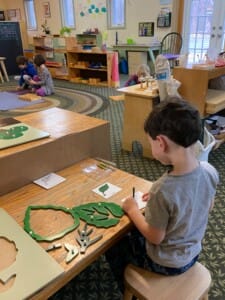 The Montessori Curriculum follows the natural, observable, progress of human development. Montessori Philosophy is grounded in over a century of practice while simultaneously maintaining connection with modern educational and neurological research. Furthermore, the Montessori philosophy aims to meet each child where they are and help them work toward their individual potential.
The Montessori Curriculum follows the natural, observable, progress of human development. Montessori Philosophy is grounded in over a century of practice while simultaneously maintaining connection with modern educational and neurological research. Furthermore, the Montessori philosophy aims to meet each child where they are and help them work toward their individual potential.
In a Montessori classroom, the adults, often called guides rather than teachers, and the environment support the child’s own interests, passions, and drives. Therefore, they work together to help young people learn to love the pursuit of knowledge and develop in to confident and healthy adults.
Our guides are trained in Montessori philosophy, and child development, and have a deep knowledge of the Montessori materials. Authentic Montessori schools have similar materials which have been proven useful, engaging, and motivating even after 100 years of global and cultural change. They are timeless because they provide opportunities for independence and isolate difficulties, allowing the child to build confidence and skill. The Montessori materials also are designed to appeal to the child’s sensitive periods for development. Therefore, they are naturally appealing and inspiring to children when presented in a way that invites exploration with purpose.
